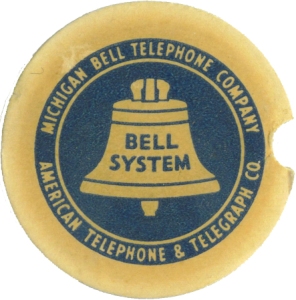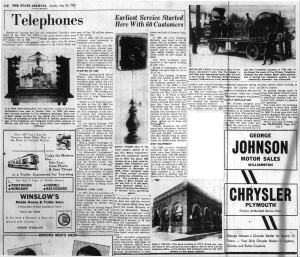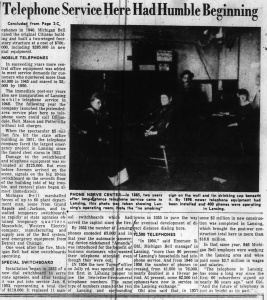Copied from The State Journal – Lansing, MI – Sunday, May 24, 1959
Telephones: Earliest Service Started Here With 60 Customers
Century-old Lansing had just come of age when the infant telephone industry was born in the capital city in 1880.
From that time to the present, telephones have strengthened and lengthened Lansing’s voice to the point where today some 92,500 telephone customers here may call more than 63 million phones in the United States and most of the 118 million phones in the world.
But in 1880, only 60 Lansing customers were interested in telephone conversation.
It was in that year that William A. Jackson, general manager of the Telephone and Telegraph Construction company of Detroit, agreed to establish an exchange here if 50 subscribers signed up. Jackson had brought Michigan’s first telephone to Detroit in 1877, establishing an exchange there the following year.
STARTED IN 1880
Jackson commissioned Alfred Beamer, then Western Union manager at Lansing, to line up customers after which the first commercially-used telephone was installed in the old Lansing House, later known as the Downey hotel. The building was torn down years ago to make room for a large department store building.
Within a year from the opening date on Dec. 16, 1880, the exchange boasted 100 phones.
Though this city did not have the first exchange in the state, a Lansing man experimented with the telephone idea three years before the actual installation.
In the period between 1876 and 1879, Dr. George P. Richmond, Lansing dentist and inventor, tinkered with electrical transmission of sound, as did many other scientists throughout the world, including Alexander Graham Bell.
With a simple diaphragm instrument, Dr. Richmond was able to carry on a conversation between his home and office.
Dr. Richmond’s “hydrophone” worked on the variable resistance principle of Bell’s “liquid transmitter” – the one which carried the historic words, “Mr. Watson, come here. I want you!” in March of 1876.
But Bell felt that the manipulation of a container of liquid and the use of “wet” batteries was not practical at that time for untrained persons, so he went on to the “magnetic induction” telephone as being easier to operate.
230-MILE LONG LOOP
In 1877, with the assistance of Beamer, Dr. Richmond connected two instruments to a Western Union telegraph line which ran from Lansing to Detroit and back again.
A story in the Lansing Republican of Nov. 19, 1877 told of setting up the 230-mile loop, connecting two instruments in different Lansing locations, and attaching a battery of 372 cups of liquid in the Detroit office. An excerpt said:
“Connections were at once made with the circuit, the transmitting instrument being placed in the grocery of H. W. Squires, one door east, and the receiver in the express office. Soon they heard the words, distinctly uttered (by Richmond), “Beamer, Beamer, do you hear me? I will sing, and in an instant the tones of ‘Marching On’ were distinctly heard at a distance of 20 feet from the instrument.
A Bell telephone then also was attached in the Detroit operating room, over which listeners there heard songs and conversations.
Many successful experiments were conducted with the Richmond instrument over lines of varying distances, but it never reached widespread use because of the introduction of new, more practical developments in telephony and lack of financial backing.
In 1881 the first telephone directory was listed with 93 names, but no numbers. Operators memorized the names and their positions on the switchboards, and as new customers were added, holders of directories wrote in new names by hand.
Only three telephones were installed in the Capitol building at that time.
Except in emergencies, the exchange was open from 7 a. m. to 10 p. m.
The first Lansing telephone office was located at 229 Washington st., but with expansion the exchange outgrew the location. Early in the 1880’s it was moved to the old State building.
First telephone operator in Lansing was Miss Nellie Potter, later Mrs. C. R. White of Baltimore. Her assistant was Miss Gertie Beamer. Other early operators included Miss Alice Carr, later Mrs. Chris Breisch; Mrs. Fred Keith, and Mrs. Alice Hill.
Early in 1883 the first long-distance line stretched out from Lansing to Mason, which was followed in June by another to Detroit. In the next two months others spread out to Ionia and Battle Creek.
Though skepticism ran high about early telephones, business places invited people in to “try the new-fangled contraption” and thus helped bring in more trade as people “threw their voices an unbelievable distance.”
NEW EQUIPMENT
By 1898, newer telephone equipment had been installed, many more long distance lines had been built, and 400 phones were operating in the community. In that year Beamer was succeeded as manager by J. H. Lyons, who was followed in 1902 by E. C. Ewer, and Glen L. Williams in 1905. Other early managers included J. E. Scott in 1908, and E. J. Holihan. Ben R. Marsh, later Michigan Bell’s vice president and general manager and chairman of the board, was manager here in 1911.
In 1902 the crank-type telephone left the Lansing scene and was replaced by the “common battery” system which permitted reaching the operator by merely lifting the receiver.
With expiration of Bell’s original telephone patents in 1893, competing companies sprang up around the country and appeared in Lansing at the turn of the century when the Citizens Telephone company was formed.
COSTLY DUPLICATION
The Citizens company gave good service for those days but required customers to have two telephones to be connected with others in town. The costly duplication of service came to an end in 1923 when the Michigan State company (which became Michigan Bell the next year) purchased the assets of its competitor. Properties included he Citizens central office building at 220 N. Capitol.
To provide enough space to house both phone systems in the building, the company erected a three-story addition and converted both systems to modern dial operation.
Two years later the exchange has grown to more than 14,000 telephones and reached 18,000 by 1930. To keep pace with that growth, Michigan Bell had erected a fourth floor atop the previous addition in 1927.
With a new high of 30,000 telephones in 1940, Michigan Bell razed the original Citizens building and built a two-winged four-story structure at a cost of $700,000, including $285,000 in new dial equipment.
MOBILE TELEPHONES
In succeeding years more central office equipment was added to meet service demands for customers who numbered more than 40,000 in 1945 and soared to 55,000 by 1950.
The immediate post-war years also saw inauguration of Lansing mobile telephone service in 1948. The following year the company launched the extended area service plan here so telephone users could call Dimondale, Holt, Mason and Potterville without toll charges.
When the spectacular $5 million fire hit the state office building in 1951, the telephone company faced the largest emergency project in Lansing since the famed sleet storm in 1922.
Damage to the switchboard and telephone equipment was estimated at $125,000. But even before firemen arrived on the scene, signals on the big 10-ton switchboard on the seventh floor of the building told of big trouble, and restoral plans began almost immediately.
Michigan Bell marshalled forces of up to 60 plant department men, some from Grand Rapids and Jackson, and installed temporary switchboards as rapidly as state agencies obtained temporary quarters. Meanwhile, Western Electric company, manufacturing and supply arm of the Bell system, sent emergency equipment from Detroit and Chicago.
One week after the fire, Michigan Bell had nine switchboards operating.
SPECIAL SWITCHBOARD
Installation began in 1952 of a new dial switchboard to serve state agencies, and after testing it was put into service Jan. 6, 1953, representing a total cost of $119,000. It replaced 1 manual switchboards which had served the capitol since the fire.
By 1952 the number of Lansing phones exceeded 65,000 and in that year the automatic answering device nicknamed “Amanda” was introduced for the benefit of business customers who wanted their telephone attended even though they were out.
IN 1954 the new Turner office on Jolly rd. was opened and was the first Lansing proper to use the two-letter-five-numeral telephone numbers. The same type of numbers came to the rest of Lansing and surrounding towns in 1955 to pave the way for eventual development of direct distance dialing here.
92,500 TELEPHONES
“In 1956” said Emerson B. Ohl, Michigan Bell manager in Lansing, “more than 90 percent of Lansing’s households had telephone service. And from 1946 to 1956 the number of phones increased from 41,000 to 76,000 nearly doubled in a 10-year period. At present, some 92,500 telephones are now in service in the Lansing exchange.”
Ohl also said that in 1957 some $2 million in new construction was completed in Lansing, which brought the post-war construction total here to more than $16.6 million.
In that same year, 846 Michigan Bell employees were working in the Lansing area and were paid some $3.7 million wages and salaries.
“The telephone in Lansing has come a long way since the first 60 subscribers signed up nearly 80 years ago,” said Ohl. “And the future of telephony is just as bright as its past.”
*
Photo Captions:
1. OLD TIME SWITCHBOARD – This old timer – called a Gilliland switchboard – was used at Golden, Colo., in 1880, the same year Lansing received its first telephone exchange. Sixty subscribers signed up here for the capital city’s first telephone service, an exchange set up by William A. Jackson, general manager of the Telephone and Telegrapg Construction company of Detroit, and the first man to bring Bell’s new telephone to Michigan.
2. EARLY PHONE – One of more modern phones of its day, this “Blake Transmitter” went into commercial service late in 1878. The above 1880 version sat on a desk stand for support. Bell Telephone company acquired rights to this transmitter in November of 1878, which improved upon the “loose contact” principle of producing undulating current. The principle was described in Bell’s original patent and still is in use today. Loose electrical contact is a means of varying the intensity of current, thus permitting speech.
3. EARLY OFFICE – This brick building at 123 S. Grand ave., now the home of the Lansing Insurance agency, was an early Lansing telephone office, as the familiar Bell telephone signs on the front window in this photo indicate.
4. INSTALLED CABLE – In the early days of telephony, equipment trucks like this helped install lines and underground cable after the turn of the century. The Michigan State Telephone company (note name on truck) because the Michigan Bell Telephone company in 1924 after it purchased the assets of the Citizens Telephone company the year before. Much costly duplication of having two telephone systems in one community thereafter was eliminated.
5. PHONE NERVE CENTER – In 1885, two years after long-distance telephone service came to Lansing, this photo was taken showing Lansing’s operating room. Note the “no smoking” sign on the wall and tin cup beneath it. By 1898 newer telephone equipment had been installed and 400 phones were operating in Lansing.




my phone number is 517-485-4070. I am 73 yrs. Old and this was my family phone number from thr time i was about 5-6 years old. W hen my mother went back and forth to Florida years later we were able to have this number switched to a cell phone for her. Then she had to go back to Michgan for medical reasons and live with my sister. At that time I 2as able to switch her number from her phone to my cell phone. I’ve had it since about 2015-2016. My carrier was Verizon but now I’m on AT&T.
When I was around 10 I learned the number as IV-54070.
My parents were Walter & LulaVene Hubble
800 Wisconsin Ave.
Lansing 15 Michigan